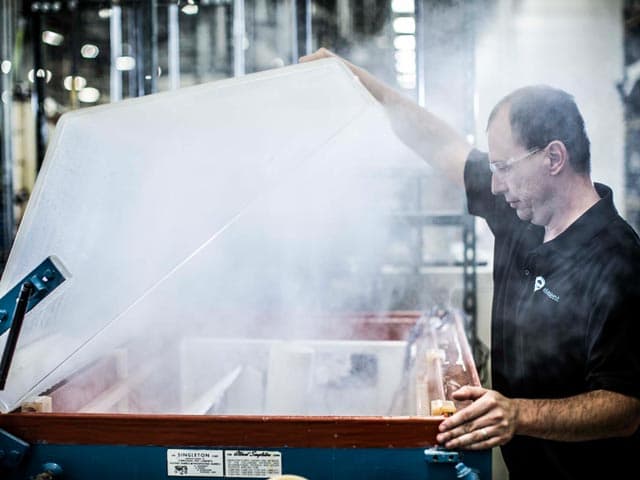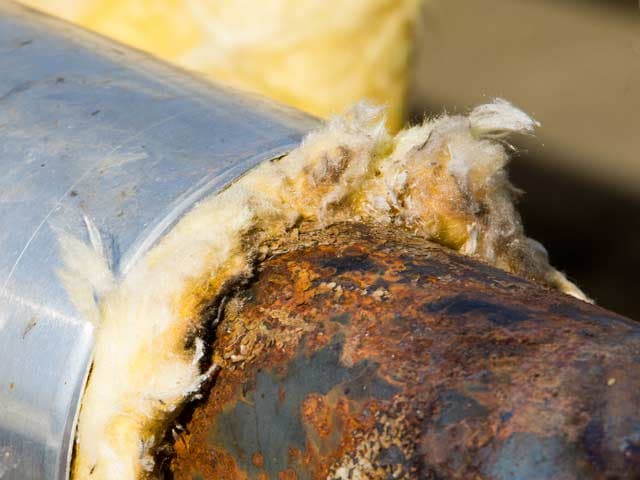Salt Spray Testing
Ensure corrosion resistance and regulatory compliance, while avoiding risk to your team and the environment. Element’s salt spray testing services help you get to market faster without compromising quality. By simulating high-saline environments, we provide accurate and reliable results that reflect real-world conditions, helping you maintain product integrity and performance.

What is salt spray testing at Element?
A salt spray test (also called salt fog testing) is a corrosion testing method that uses high-saline environments to measure the corrosion resistance of products, paints, and coatings over extended periods. This accelerated process applies a 5% NaCl (sodium chloride) solution to coated or painted equipment. At Element, we can adjust our salt spray testing for specific requirements to simulate different climates or working conditions. Samples are checked regularly to monitor corrosion levels, noting milestones such as white and red rust development or coating degradation. Our labs provide detailed test reports with before-and-after photographs, calibration data, time/date records, and Element's certifications.

What can Element offer you for salt fog testing?
Environments we can simulate
Environments we can simulate
Elements' alternative salt spray testing can simulate a variety of corrosive environments to ensure the integrity of a product. Some of our capabilities include:
- Neutral salt spray (NSS)
- Acetic acid salt spray (ASS)
- Copper-accelerated acetic acid salt spray (CASS)
- Calcium chloride (CaCl₂)
- Synthetic seawater testing
- Hydrogen-induced cracking (HIC)
- Custom cyclic corrosion testing
Components and materials we test
Components and materials we test
Element specializes in testing a wide range of materials, from automotive and aerospace coatings to industrial metals and electronics. Whether you're evaluating large assemblies or small fasteners, we ensure precise and relevant results tailored to your industry needs.
Methods and solutions offered
Methods and solutions offered
We provide customized testing conditions, including temperature, humidity, and salt concentration variations, meeting diverse standards like ASTM B117 and ISO 17025. You will also receive comprehensive test reports, including pictures and descriptions at each stage of testing, enhanced with detailed element analysis if required, facilitating informed decision-making.
Cutting-edge equipment we use
Cutting-edge equipment we use
We use advanced chambers to replicate real-world environments, exposing samples to salt-laden mist, temperature, and humidity variations. For large or unusually shaped components, our largest chamber is 8’H x 8’W x 10’L, and can reach temperatures of up to 55°C.
Labs offering this service
Labs offering this service
With accredited labs around the world, we deliver timely results, ensuring that your projects stay on track regardless of geographical location.
Standards we test to and materials we test
American National Standards Institute
ANSI/SCTE 143SCTE
American Society for Testing and Materials
ASTM B117, ASTM B368, ASTM D1654, ASTM D1745, ASTM D2247, ASTM G85
General Motors
GM 4298, GM 9540
International Electrotechnical Commission
IEC 60068, IEC 60945, IEC 68-2-11
International Standards Organization
ISO 9227, ISO 12944, ISO 20340
Military Standards
DEF STAN 07-55, DEF STAN 00-35, MIL-STD-202, MIL-STD-810, MIL-A-8625, MIL-F-5541, MIL-DTL-5541, MIL-STD-1312, MIL-STD-883, RTCA DO-160
National Electrical Manufacturers Association
NEMA 250
Netherlands Normalisatie-Instituut
NEN 10068
Society of Automotive Engineers
SAE J1810, SAE J1211, SAE J2334
Telecordia
GR-487-CORE
Underwriters Laboratory
UL 2703, UL 50
Expert GMW 3172 Testing
Element offers tailored GMW 3172 testing to ensure your electronics perform in corrosive environments. We can support programs with virtually any condition listed in the standard, including environmental conditioning and functional tests. our experts can help you design a GMW 3172 test program that conforms to test requirements while meeting your product’s unique needs.
Coatings & Paints
- Electroplated copper-nickel-chromium
- Electroplated copper-nickel
- Anodized aluminum
Industrial & Automotive Components
- Marine equipment
- Automotive parts
- Military equipment
Large or Custom Components
- Oversized parts up to 8’H x 8’W x 10’L
- High-temperature materials (up to 55°C)
Your Challenges, Our Solutions
Meeting Tough Industry Standards
Preventing Corrosion Before It Happens
Handling Large and Complex Components
Testing Across Diverse Materials
Why Choose Element

Global Accredited Labs
Accurate and Reliable Testing
Industry-Specific Expertise
Comprehensive Reporting
100+Years
55°C Chamber Capacity
ISO 17025& NADCAP accredited labs
5 Regions supported

But don't just take our word for it
See what others have to say about partnering with Element
Frequently asked questions
What is the difference between salt spray and salt fog testing?
From a testing standpoint, salt fog testing and salt spray testing are the exact same test, with names often used interchangeably. These tests are often referred to by these different names because the levels of salt being applied vary accordingly to the specific environmental conditions needed to be replicated.
What are the outcomes of ASTM B117 testing?
The test provides visual inspection results on corrosion resistance, coating adhesion (combined with ASTM D3359), and corrosion development from scratches (combined with ASTM D1654). Note: correlating results to real-world conditions is challenging.
When is it not recommended to use ASTM B117?
It is not recommended for products with decorative chromium plating, zinc die castings, or cadmium plating on steel. For these, consider ASTM B368 or Practice G85 instead.
What are the testing conditions for ASTM B117?
The test is performed in chambers with a temperature of 35°C (+/- 2°C), neutral pH (6.5–7.2), and a salt concentration of 5% sodium chloride. Exposures are typically 96, 240, or 600 hours.

Explore our global network of labs and find your nearest location
VIEW ALL LOCATIONSRelated Services

Corrosion Testing Services
Learn about our range of ISO/IEC 17025-accredited corrosion testing services. Safeguard your assets, ensure reliability, qualify welds, assess materials and enhance safety.

CUI Inspection - Corrosion Under Insulation
Identify hidden corrosion under insulation before it leads to costly failures. Element's advanced CUI inspection protects infrastructure & extends equipment life, meeting industry standards. Learn More.

Sour Service Corrosion Testing for NACE MR0175/ISO 15156 Compliance
Element provides industry-leading sour service corrosion testing, helping oil and gas companies mitigate corrosion risks, comply with NACE MR0175/ISO 15156, and enhance material reliability in challenging environments.

Climatic & Environmental Chamber Testing Services
Test your products' durability with environmental chambers at Element. Accurately simulate real-world conditions to meet industry standards and ensure performance.

Product Qualification Testing (PQT) Services
Element’s product qualification testing verifies safety, compliance, and performance, helping businesses reduce risk, accelerate market entry, and meet global standards with expert guidance and accredited testing services.
